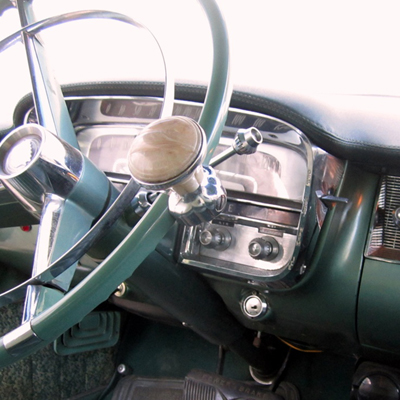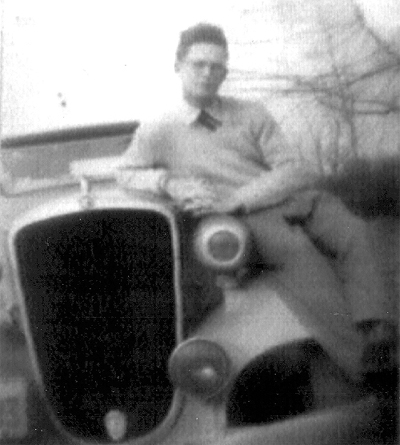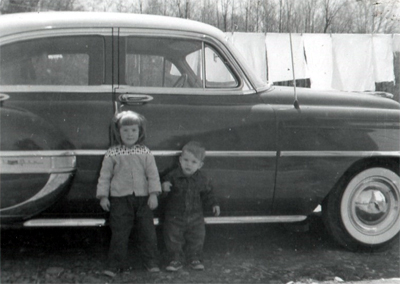-
Cars
When I was young, cars were still having their heyday. They were fat, flashy and fast. What you did, who you were, how you saw yourself, was all wrapped up in what sort of car you drove.
You went everywhere in cars, and did everything—drank, ate, relaxed, listened to music, smoked, talked with your friends, and had sex—in cars. And when you weren’t in your car, you were outside it, washing it, tinkering with the engine, polishing the tires, or shining the chrome on the bumpers.
If you had a less-than-flashy car, you were a loser. If you had no car at all, you were nothing.
I was nothing.
I didn’t get a car until after I graduated from school. This was mainly because I couldn’t afford one, so you see, what car you owned—or did not own—really did show off your social status. The car I eventually bought didn’t help much. It was a ten-year-old Ford Falcon. I only had it a couple of months before it rolled away from me and smashed into a tree.
This is the story:
Early on, the car lost reverse gear. I could go forward, but not backward. This didn’t present much of a problem. I lived in the country; there was a lot of open space. Then one evening, after dark, I was coming home along Route 9H and something smacked into the side of my car. I pulled off the road, did a three-point turn (which involved getting out and pushing the car backwards) then went back to the scene.
There, in the road, very dazed and undoubtedly with a pounding headache, was an owl. I eased past him, then proceeded to do another three-point turn, figuring I would stop and get the owl, take him home and see if my mom could nurse him back to health. I swung around, put the car in neutral, got out to push it backward and it rolled off the road, down the embankment and smashed into a tree.
Then the owl flew away.
So, there I was, alone on a dark, deserted road. I walked to the nearest house and they allowed me to use their phone. I called my house and…
This requires another story. My youngest brother was a strange child who went through several phases as he grew up. For two years, he ate nothing but peanut butter sandwiches. Another time, he lifted weights maniacally. At this particular time, however, he was going through a phase where he didn’t talk. This didn’t bother us so much, except when he sat by the phone. The phone would ring, he would pick it up, listen for a short while, then put it down.
“Who was that?” we’d yell at him. But he, naturally, kept silent.
And so, I called home, and he answered. “Hi, it’s Mike, I’ve had an accident with the car, I need help—” Click.
I called back. “Do not hang up! I’ve had an accident—” Click.
In the end, I walked home. The next day, I had to hire a tow truck to extract the wreck from the bushes.
The Ford went to the automobile graveyard and a buddy of mine gave me an old Chevy Bel Air he wasn’t using. That pretty much sums up the car culture within my social group—we always had a car, or two, but they were junk, and fairly ephemeral. We were not the greasers of the 50s. We were the poor white trash of the 60s.
But, junk or not, the cars were amazing. They were huge, and had fins and bench seats in back and front. In an average car, you could easily sit seven people—three in the front and four in back. In a pinch you could squeeze in a few more. My record was eleven.
They were also, lethal, with knobs protruding from metal dashboards, no seatbelts—or if they were there, you didn’t wear them—and a complete lack of safety features (air-bags were a good twenty years in the future). A fair number of my friends and acquaintances died in cars from a combination of too much power, too little experience and too much booze.
Unlike today, many cars had the gear shift on the steering column, even those with a standard transmission. If you had bench seats in front, this meant you could make your passenger slide toward you by taking a sharp right turn, as there was no gearshift in the way. These were called COD corners (Come Over Darling). And if you had a make-out knob on your steering wheel (a handle so you could drive one-handed) you could take full advantage of the COD corners.

I found out, while writing this, that these
are also known as ‘Suicide Knobs.’ I, however, have
only known them as ‘Make-Out Knobs.’One of the more interesting cars I owned was a Delta 88, a car so big I could lay out flat on the back seat. It was the fastest car I ever owned, but the speedometer didn’t work, so I never knew how fast I was going, all I knew was no one ever passed me. It had the largest engine ever made for a car in it—455 cubic inches. It roared like a monster. It got seven miles to the gallon.
Cars were easy to steal back then, so it was a good thing all I ever drove were junkheaps. To unlock a car, you just had to wiggle some coat-hanger wire over the top of the window, then snag the door lock and pull it up. They were big buttons in those days, with a mushroom-like top, making it handy for opening with a bent piece of wire.

This is what a car door looked like when I was first driving. Easy to unlock from the outside, and no fancy buttons to raise and lower your windows. (I understand this can still be done, but I imagine it is a lot harder.)
Mostly we did this to get into our own cars after accidently locking ourselves out. But one time I broke into my brother’s car, got the serial number off the door and had a key cut so I could take it when he wasn’t around because, well, why wouldn’t you?
In general, however, we didn’t bother locking our cars. We even left the keys in the ignition, Dad included. We lived in the boondocks, so there wasn’t any crime to speak of. We also never locked the doors to the house.
There was no such thing as a locking gas cap back then, either. Why would you steal gas? Or pour something, like sugar, into someone’s gas tank? Okay, occasionally someone might “borrow” some gas from a neighbour, or a small child—me, for instance—might decide to help daddy by filling his gas tank with water scooped out of a mud puddle. But, for the most part, the idea of a gas cap that locked wasn’t worth thinking about. Gas was cheap back then. My earliest recollections—we used to wait for the bus by Charlie Barton’s garage, so I was well aware of the price of gas—was 35 cents a gallon. And 25 cents for a pack of cigarettes out of the vending machine.
My dad was not a hold-over from the 50s car generation. To my dad, cars were simply a practical tool, necessary for getting you places and carrying things. (Although, when he was a young man, my dad owned an Essex Terraplane, which I believe was a flash car back in the day. My granddad owned a Rambler.). If they broke down, you fixed them, but there was no endless fiddling with the motors. I can’t say that was what influenced me, but I feel the same way, and always have. I knew how to fix them, because that was a necessity of life, but I always said, even as a teenager, that as soon as I had the money to pay someone else to work on my car, I would. And so it was.
It must be said, however, that the cars I and my father knew were not the complex, computer controlled, high precision machines of today. They were fairly basic, and anyone of average intelligence and means could change the oil, fit new spark plugs, change the header gasket, replace the fan belt, put in a new starter, replace a worn-out transmission or, indeed, swap out the entire engine. I did all of these, with little knowledge and less enthusiasm. Today, however, I couldn’t even top up the oil. When I open a hood, there is nothing under it that I recognize.
It also needs to be said that the cars of my day were run by combustion engines powered by gasoline. As I write this, electric cars are on the rise, so it may be, in ten or twenty years’ time, we will be telling young people, “In MY day, we had to fill up our GAS TANK at a GAS STATION.” And the young people will look at us with wonder and ask, “But isn’t gasoline flammable? Wasn’t that terribly dangerous?” To which, if we’re being honest, we would have to reply, “Indeed, it was.”
My father’s laissez-faire attitude toward vehicles led to us having some remarkable automobiles, all—it goes without saying—second (or third or fourth) hand. At one time, we had a Thames Van, which had been made in England and therefore had nuts, bolts and many other important parts in measurements foreign to us. The van had bench seats in the back, upon which we were bounced and jostled and otherwise thrown about as my dad drove over the rough dirt roads.
My most vivid memory involving the van came about while he was transporting a snapping turtle. It was in a wooden crate held closed by a thick metal cable and it was in the back of the van for a day or two. We got in the back of the van to go somewhere and I happened to look at the crate the turtle was supposed to be in and found it empty. The turtle had snapped through the cable and escaped, and we were in the van with the turtle. We all screamed and jumped out. (The turtle had just bitten through a steel cable—this is not an animal you want to share close quarters with.) My dad eventually captured it. It was hiding under a seat, its jaws facing out, so you couldn’t grab it, so my dad stuck a two-by-four into the turtle’s mouth and, when it bit down, he pulled it out of the van. It continued to cling to the two-by-four, allowing him to lower it back into the crate.
Another time, when our current used-car went to the big junk-yard in the sky and dad went out to get a replacement, he came home with a mammoth, pink station wagon. Mom was horrified, but he thought it was quite a joke. So did I, and it was one of the few times I felt we really had something in common. If I had seen that car on the lot, you couldn’t have stopped me from buying it.
I put the same thought into the procurement and care of my own vehicles. Over the years, I drove cars that had no floors, no heat, no back up lights, no functioning starter and, as I already pointed out, no reverse gear.
When one of my cars, with the shift lever on the steering column, needed a new transmission, I installed a new one (new to the car, that is; I got it out of a junk-yard) and realized, too late, that it was a floor-shifting model. No problem. I cut a hole through the floor and rigged up a rudimentary shifter using an old piece of wood. It was, as everyone I gave a ride to noted, an actual “stick shift.” HAHAHAHAHAHAHA. (This car, of course, had an automatic transmission. Standard, or manual, transmissions were not prevalent while I was growing up. Almost every car I ever owned or borrowed had an automatic — or a PRNDL, which we called “Pernundel” — gear shift.)
In another car, when the windshield wipers broke, I ran a cord from one wiper, through the triangular side window, across the interior to the other side window and attached it to the other wiper. When it rained, I just yanked it back and forth. It worked a treat and didn’t cost me a dime.

Back in the day, cars had a small, triangular window at the front of the
front windows. I think they were called vent windows.
They were useless, except as a means of running a
cord through the car to operate the windshield wipers.I’m sure kids still drive around in junk cars, but you could never get away with that sort of nonsense today. And those “modifications” were in addition to the bald ties, broken mufflers, cracked windscreens and various non-functioning lights we drove around with. It’s also worth noting that the windshield wiper fix described above was not done when I was a kid. I was in my twenties when I did that.
These days, I still drive used cars (because brand new cars are hugely expensive) but they are of a better quality than the hand-me-downs I drove in my younger years. Granted, I no longer have adventures, like getting a flat at 2 AM in a car with no heat when it is -20F outside, hauling the spare out of the trunk only to find that, it too, is flat, and then having to drive fifteen miles home on the rim, but I’m willing to trade that sort of exhilaration for the comfort and peace of mind that comes with roadside assistance insurance and functioning heat.




